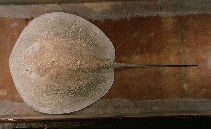| Family: |
Dasyatidae (Stingrays), subfamily: Urogymninae |
| Max. size: |
147 cm WD (male/unsexed) |
| Environment: |
reef-associated; brackish; marine; depth range 15 - 217 m, |
| Distribution: |
Indo-Pacific: Red Sea and coast of East Africa to the Marshall Islands and Fiji, south to northern Australia (Ref. 2334). Eastern Atlantic: Senegal, Guinea, and Côte d'Ivoire (Ref. 4438). |
| Diagnosis: |
Diagnosis: A heavily armored stingray lacking a venomous barb; young with large, flat denticles on upper surface, and large juveniles and adults with additional sharp conical thorns and small, pointed denticles (Ref. 5578).
Description: Very large stingray with an extremely thick, oval disc, with broadly rounded outer corners (Ref. 5578, 81259). Snout broadly rounded (Ref. 5578). Dorsal surface very rough, its central area covered with flattened, heart-shaped, dermal denticles, and a very large number of conical, pointed, thorny tubercles scattered over the entire disc (Ref. 81259). Tail slender, about as long as body, very spiny, but sting always lacking; ventral tail fold reduced or absent (Ref. 5578, 81259).
Colouration: Light grey or whitish dorsally, white ventrally; tail whip blackish (Ref. 5578, 81259). |
| Biology: |
Inhabits the continental shelf area (Ref. 2334), but capable of entering coastal lagoons (Ref. 81259). Found on sand and coral rubble areas near reefs (Ref. 9840), often in caves. Ovoviviparous (Ref. 50449). Due to its difficult handling, it is probably of limited commercial value (Ref. 9840). Its thorn can inflict a painful injury; caught commonly by demersal tangle net fisheries; utilized for its meat, skin (very high value) and cartilage (Ref.58048). |
| IUCN Red List Status: |
Endangered (EN); Date assessed: 16 June 2023 (A2cd) Ref. (130435)
|
| Threat to humans: |
traumatogenic |
Source and more info: www.fishbase.org. For personal, classroom, and other internal use only. Not for publication.
